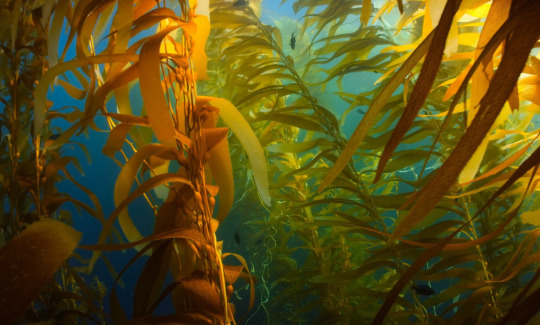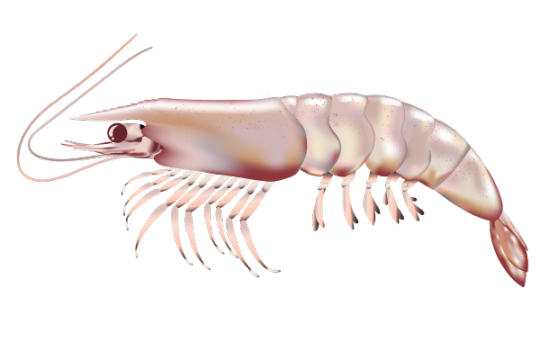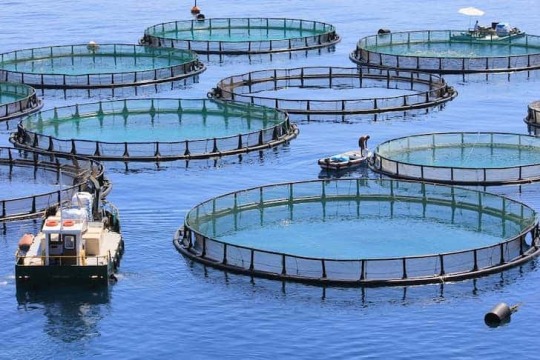#aquaculture in India
Text
youtube
Every week, Eco India brings you stories that inspire you to build a cleaner, greener and better tomorrow.
Around the world irrigation, drought and sea level rise are increasing the salinity of the soil – and stunting crop productivity. One of India’s worst affected states is Punjab, known as the country’s granary. There, the problem is compounded by waterlogging. To help maintain farmers' livelihoods, scientists are replacing wheat fields with ponds, to farm an animal normally found hundreds of kilometers away – in the sea.
CREDITS:
Supervising Producer: Nooshin Mowla
Script: Jessica Goel, Nooshin Mowla
Field Producer: Jessica Goel
Video Editor: Richard Kujur
Associate Producer: Ipsita Basu
Director of Photography: Richard Kujur
Executive Producer: Sannuta Raghu
#eco india#scroll.in#solarpunk#tidalpunk#shrimp#india#Punjab#farm#farming#water#ponds#shrimp farming#aquaculture#Youtube
4 notes
·
View notes
Photo

(via Pilot Program Builds a Better Seaweed Supply Chain)
Disclosure: I am a supporter of Food Tank.
As phyto- and seaweed aquaculture develop I’m increasingly wary of invasive species. However, knowing so little about the ocean despite being within walking distance of a major bay I don’t know if the concern is irrational or not. Thoughts? Or better, facts?
2 notes
·
View notes
Text
India things!
Recently, the Ministry of Fisheries, Animal Husbandry & Dairying has discussed the technical challenges in the implementation of the Aquaculture Crop Insurance scheme for Shrimp and Fish farming under the Pradhan Mantri Matsya Sampada Yojana (PMMSY) scheme.
To mitigate the risks faced by aqua farmers, NFDB (National Fisheries Development Board), which is the nodal agency for implementation of PMMSY, proposeed to implement the Aquaculture Crop Insurance scheme.
The Scheme aims to provide basic cover for brackish water shrimp and fish on pilot basis for one year in the selected States of Andhra Pradesh, Bihar, Gujarat, Madhya Pradesh and Odisha.
The term aquaculture broadly refers to the cultivation of aquatic organisms in controlled aquatic environments for any commercial, recreational or public purpose.
The breeding, rearing and harvesting of plants and animals takes place in all types of water environments including ponds, rivers, lakes, the ocean and man-made “closed” systems on land.
#general knowledge#affairsmastery#india#generalknowledge#current events#current news#aquaculture#fishery#shrimp#crop insurance#ocean#environment
0 notes
Text
Exploring the Importance of Good Gut Health in Aquaculture

In the world of aquaculture, where the well-being and growth of fish are paramount, an often-overlooked factor plays a crucial role: gut health. Just as in humans, the digestive system of fish is a complex and intricate network that significantly impacts their overall health and performance. In this blog, we will delve into the importance of maintaining good gut health in aquaculture and how it contributes to the success of fish farming operations, with a special focus on the innovative solutions provided by Skretting.
The gut serves as a foundation for fish health, as it is responsible for efficient digestion, nutrient absorption, and the prevention of various diseases. A healthy gut ensures that the fish can effectively utilize the nutrients from their feed, leading to optimal growth, improved immunity, and enhanced overall vitality.
A well-functioning gut is essential for optimal digestive efficiency. It allows fish to break down and absorb nutrients from their feed more effectively, ensuring that they receive the essential proteins, lipids, carbohydrates, vitamins, and minerals necessary for growth and development. Proper digestion also helps reduce feed wastage and the release of undigested nutrients into the environment, minimizing the ecological footprint of aquaculture.
A robust gut health promotes a strong immune response in fish. The gut houses a significant portion of the fish's immune system, containing specialized cells that defend against harmful pathogens and diseases. A healthy gut microbiota, the diverse community of beneficial bacteria living in the fish's digestive tract, plays a crucial role in modulating the immune system, preventing the colonization of harmful bacteria, and supporting the fish's overall disease resistance.
In aquaculture, feed conversion ratio (FCR) is a key indicator of efficiency and profitability. Good gut health directly influences FCR by enhancing nutrient utilization and reducing the energy expenditure required for digestion. Fish with a healthy gut can convert feed into flesh more efficiently, resulting in reduced feed costs and improved economic viability of aquaculture operations.
Maintaining a balanced gut microbiota is vital for fish health. Factors such as stress, improper nutrition, and suboptimal water quality can disrupt the delicate balance of beneficial bacteria in the gut, leading to dysbiosis or an imbalance in the gut microbial community. Dysbiosis can negatively impact digestion, nutrient absorption, and disease resistance, ultimately affecting the growth and overall well-being of the fish.
Skretting, a leading provider of aquaculture feed, recognizes the significance of gut health in fish farming. They offer a range of specialized feed solutions that are designed to support optimal gut function and overall fish health. Skretting's feeds are formulated with carefully selected ingredients and additives, including probiotics and prebiotics, to promote a healthy gut microbiota and ensure efficient digestion and nutrient absorption.
Skretting's commitment to sustainability and innovation is evident in their feed solutions. They continuously research and develop new feed formulations that not only improve fish performance but also minimize environmental impact. By optimizing the nutritional composition and incorporating alternative protein sources, such as plant-based proteins and insect meal, Skretting contributes to a more sustainable and responsible aquaculture industry.
In aquaculture, good gut health is essential for the success and sustainability of fish farming operations. By prioritizing efficient digestion, supporting immune function, optimizing feed conversion, and maintaining a balanced gut microbiota, aquaculturists can enhance the overall well-being and growth of their fish. Skretting's innovative feed solutions play a crucial role in promoting good gut health and providing aquaculturists with the tools they need to thrive in a sustainable manner. With a focus on excellence and environmental stewardship, Skretting is at the forefront of advancing aquaculture feed for a healthier and more prosperous industry.
Explore more about us: https://www.skretting.com/en-in/
Contact us at https://www.skretting.com/en-in/this-is-skretting/contact/
#aquaculture india#aqua feed#aqua nutrition#fish farming#aquaculture#shrimp feed#whiteleg shrimp#shrimp culture
1 note
·
View note
Text
Understanding Aquaculture Probiotics In Detail
Aquaculture probiotics are a group of beneficial bacteria that are used in the aquaculture industry to enhance the health and growth of farmed aquatic animals. These probiotics have been gaining popularity in recent years as a natural and sustainable solution to improve the overall health and well-being of farmed fish and other aquatic animals.
In this article, we will explore what aquaculture probiotics are, their benefits, how they are used in the aquaculture industry and where you can find all kinds of aquaculture products.
These are added to the diets or culture water of farmed aquatic animals to promote their health and well-being. These microorganisms include various strains of beneficial bacteria, yeast, and other microorganisms that are found naturally in the gut of fish and other aquatic animals.
When added to the diet or culture water of farmed aquatic animals, these probiotics help to improve the balance of beneficial bacteria in their digestive systems, which can improve their overall health and growth.
Benefits of aquaculture probiotics
There are many benefits to using aquaculture probiotics in the farming of aquatic animals. One of the main benefits is that they help to promote the growth and development of farmed fish and other aquatic animals. This is because the probiotics help to break down the feed more efficiently, which means that the fish can absorb more nutrients from their food. This, in turn, leads to faster growth and development.
Another benefit of aquaculture probiotics is that they can help to improve the overall health of farmed fish and other aquatic animals. This is because probiotics help to maintain a healthy balance of bacteria in their gut, which can help to prevent the growth of harmful bacteria that can cause disease. In addition, probiotics can help to boost the immune system of farmed fish and other aquatic animals, making them less susceptible to disease and other health problems.
Using aquaculture probiotics in the aquaculture industry
Aquaculture probiotics are used in a variety of ways in the aquaculture industry. One of the most usual ways is to add them to the feed of farmed fish and other aquatic animals. This is typically done by mixing the probiotics with the feed before it is given to the fish. In some cases, the probiotics may also be added to the water in the fish tanks or ponds.
Another way that aquaculture probiotics are used in the aquaculture industry is to add them directly to the culture water. This can be done using multiple methods, including spraying the probiotics onto the water surface or adding them to the water filtration system. By adding the probiotics directly to the culture water, they can help to improve the overall health of the aquatic animals and promote faster growth and development.
Choosing the right aquaculture probiotics
When choosing aquaculture probiotics, it is important to select the right strains of bacteria and other microorganisms for the specific species of aquatic animal being farmed. Different strains of probiotics are more effective for different species of fish and other aquatic animals, so it is important to do your research and choose the right probiotics for your needs.
In addition to choosing the right strains of probiotics, it is also important to select high-quality probiotics that are proven to be effective. Look for probiotics that have been tested in scientific studies and have been shown to improve the health and growth of farmed fish and other aquatic animals.
In case you’re looking for the right aquaculture probiotics, you should explore Finar. They have successfully established themselves as the best aquaculture probiotics manufacturers in India. Don’t wait anymore! Check them out now!
0 notes
Text
Avanti Feeds - Shrimply Irresistible
In this week’s Stock Insights, we will discuss Avanti Feeds, which manufactures shrimp feeds and exports processed shrimp. Avanti Feeds started its commercial operations in 1993 under the able leadership of Late Sri Alluri Venkateswara Rao in technical collaboration with Pingtai Enterpries, Taiwan.
#Avanti Feed#Stock Insights#Aquaculture Farms#Stock Screener India#Stock Screener#Stock Market Website#Share Market Website#Tool for stock Analysis#Stock Analysis
0 notes
Text
Aquafeed enzymes market is expected to expand at a compound annual growth rate of 7.80% over the forecast period of 2021 to 2028
#aquaculture feed market#aquafeed market size#aqua feed market in india#aquafeed additives market#aqua feed business#global aquafeed production#global fish feed#aquafeed products
0 notes
Link
Aquaculture and Fish Farming in India. Get Name, Address and Contact details for Aquaculture and Fish Farming in India. A large extent of Indian aquaculture is still based on traditional farming methods. Converting them to modern farming methods will increase fish
0 notes
Photo

Aquaculture Farming in India: AS Agri & Aqua uses Latest technology in fish farming and prawns farming. To get a good return for investment.
0 notes
Text
India Fisheries & Aquaculture Market Data Review (2016 - 2027)
India Fisheries & Aquaculture Market Data Review
#India Fisheries & Aquaculture Market#India Fisheries & Aquaculture Market share India Fisheries & Aquaculture Market size
0 notes
Text

"We've got something incredible in the works, and we can’t wait to share more with you.” "Mark your calendar, Something amazing is coming your way"
HM Digital India Pvt Ltd!!
Website: https://hmdigitalindia.com/
HM Digital India Pvt Ltd #hmdigital#india#meter#watertesting#watertestingequipment#watertestinglab#watertreatment#tdsmeter#tempmeter#labtesting#watermeter#hydroponics#aquaculture
3 notes
·
View notes
Text
Menagerie
hey hey people been a minute but I finally got some time to write out some stuff so here's the final civilization on remnant! now presenting
The Menagerie Company
Mega-corporation: This government is a form of plutocratic oligarchy, where the entire state has been organized as a massive commercial enterprise overseen by a board of directors.
ethics (the broad strokes of the culture)
fanatic xenophile: If there ever was such a thing as an absolute moral imperative, it would be to explore the cosmos and embrace all within it. We were never meant to journey alone.
Egalitarian: Any society that does not embrace equality between its members - where an individual can rise to any position with enough hard work - is not only deeply unfair, but ultimately counterproductive.
civics (how those ethics are applied)
Private Prospectors: Building better worlds is hazardous work, but this Megacorporation relies on private prospectors to chart and establish footholds on promising planets.
Franchising: This megacorporation relies heavily on franchising. Subsidiaries share a greater cut of their profits with their corporate overlord, in exchange for a license to market their goods under established brands.
Anglers: Adept at utilizing nature's bounty, this society provides for itself a stable influx of sustenance and economic value.
(bonus civic just cause i like em)
Catalytic Recyclers: This megacorporation seeks to maximize profits by recycling excess organic matter into advanced resources suitable for Grim-proof structures. (they turn fish into metal via chemistry)
the menagerie company was originally a trading company from vale, while on an exploration of the south anima sea they stumbled across a new species, vale being vale sought mainly to trade with these people their young warriors in the federal army often being sent south to protect the tribes of the area and while minstral, atlas and vaccuo hated the new species the faunas grew to love humanity as a whole since their only interactions were basically with the Menagerie company who over time subsumed and was taken over by the native tribes.
each major city is considered it's own subsidiary of the overall company though only those who invest are on the board of directors, that said the valen values of equality never went away and everyone is at least given the opportunity to rise though most end up mainly just being cogs in the machine, that being said they get paid well and have plenty of lessure time so most don't mind, with a robust social security system to ensure that even the unemployed remain a functioning part of the economy the faunas are the closest thing to a utopia in remnant, it's a shame the valens prefer their constant battles and the other humans don't wanna join the corporate culture of menagerie.
basically, the East India company if they were unabashedly the good guys.
menagerie is famous for it's fishing industry who through a chemical process known only to the faunas creates 90% of vale's metals for their roaring war economy. as well as producing most of the seafood in the world.
private fleets protect their aquacultures with charismatic pirates and privateers leading the various fleets of the area. these are mercenary companies given leave to hunt in the waters around menagerie and sell whatever spoils they gather. most of the worlds navies come from menagerie as well.
when the menagerie company opens a new subsidiary they typically do so via investments in local tribes rather than sending out new settlers, though they do so occasionally and especially when moving to one of the smaller islands around the world. but when heading inland through menagerie? yeah just invest in the local tribes and build them up into subsidiaries worth a damn from the comfort of your own home.
the white fang are faunas supremisists who think that while humans are good creatures the fact that only one of their counties actually functions without making everyone miserable means that clearly they need to be put under faunas management. it's not humanities fault that they're so bad at this but they need to be protected.
as for the rest of menagerie and faunas as a whole? human fetishists, they all believe that normal humans are good moral people who only want to help but they're unfortunate enough to have evolved to dominate the area around them. so long as they're not pressured they are inherently good and will only do good things. it's the grimm that corrupt them. also every faunas dreams of bedding a human.
like i said, human fetishists, that xenophile ethic isn't just for show. that being said due to social pressures men tend to die more often then females (mainly due to grimm and carrying levels of aggression chemicals from animal traits. you don't make good decisions when you're young and you have instincts to posture or outright charge at the beasts of extinction.) as a result marriage isn't a major thing to them and children are raised communally by women (typically child care is a job paid for by your local subsidiary) with men mainly acting as role models while out doing their jobs or fighting grimm perpetuating the cycle. this is a problem as while they can breed with humans the only ones who want to are valens and valens are big into marriage and only having one mate.
it's really weird to the faunas.
blake is a human fetishist who got the opportunity to train in vale thanks to her mother's position of CEO for a local subsidiary and board member of the menagerie company. with her father leading the belladonna company, a group of privateers who hunt pirates and grimm for profit.
she's determined to get at least 3 human lovers while she's studying maybe one of them will be a guy if she's lucky! (poor sun keeps trying but she's not into faunas, though don't count our boy out yet he survived being a slave in vaccuo, he don't give up easily)
again good guy east India company but this time the natives are racist against the colonizers.
@weatherman667
@howlingday
thoughts on the menagerie company?
32 notes
·
View notes
Text
GEMMA MICRO - A complete range of micro diet particles for Marine Fish Hatcheries

GEMMA MICRO is a patented Artemia replacement diet which represents a re- liable optimised nutrition to follow on from rotifers, improving growth rates and reducing costs. GEMMA Micro is a perfect transition diet between live feeds and dry feeds which ensures maximal digestion, growth and development.
GEMMA Micro is formulated with a high percentage of soluble hydrolysed marine proteins, marine fatty acids and phospholipids as well as with optimum levels of vitamins, minerals and micro ingredients. The multiple marine protein content coupled with the unique production process results in a diet which is extremely attractive to the larvae and easily digested. As a result, enriched Artemia nauplii can be economically and successfully replaced.
GEMMA Micro is easy to use whether feeding by hand or by automated micro-feeders as it spreads readily on the water surface and sinks slowly and is available in 4 ranges. With GEMMA Micro, the weaning period is short and fry are extremely vigorous and move readily onto the next feeding phase.
BENEFITS
Improved performance
Reliable quality of the dry feed
Released staff time for fish production compared to live feed
Greater production consistency & growth rates
More vigorous fry
Reduced risk of introducing pathogenic bacteria & viruses to the rearing system
To know more and Discover Products based on your need, Click here:
Contact Details:
Email: [email protected]
Phone: +91 73047 95555
0 notes
Text
The Best Aquaculture Products: Probiotics!
Aquaculture probiotics are live microorganisms that are added to the aquatic environment to promote the growth, health, and overall well-being of aquatic animals, such as fish, shrimp, and oysters. These probiotics are similar to those used in human and animal health, and they work by establishing beneficial microbial communities in the aquaculture environment. Probiotics can help improve nutrient utilization, enhance immune function, and reduce the occurrence of harmful pathogens.
What are the benefits of probiotics in aquaculture?
The use of probiotics in aquaculture has several benefits. Here are some of their uses in aquaculture:
Improve digestion and nutrient utilization: Probiotics can improve the digestive capacity of fish and other aquatic animals, leading to better nutrient utilization and growth.
Enhance immune function: Probiotics can boost the immune system of fish and other aquatic animals, making them more resistant to diseases and infections.
Reduce the risk of diseases: Probiotics can help create a healthy microbial community in the aquaculture environment, reducing the risk of harmful pathogens and diseases.
Improve water quality: Probiotics can help break down organic matter in the water, reducing the buildup of ammonia and other harmful substances that can negatively impact aquatic animals.
Increase survival rates: Probiotics can increase the survival rates of fish and other aquatic animals by improving their overall health and reducing stress.
What are the steps in choosing the right aquaculture probiotics?
Whenever you’re choosing aquaculture products like probiotics, it is important to keep a few things in mind like-
Identify the target species: Different species of aquatic animals have different requirements, and it is important to select probiotics that are appropriate for the target species.
Identify the intended benefits: Determine the specific benefits that are desired, such as improved growth, disease resistance, or water quality improvement.
Research available probiotics: There are many types of probiotics available on the market, and it is important to research and compares different products to find the options that are best suited to the target species and their intended benefits.
Evaluate the quality of the probiotics: It is important to choose probiotics that are of high quality and have been properly tested for safety and effectiveness.
Consider the mode of administration: Probiotics can be administered in different forms, such as feed supplements or water additives, and it is important to choose the appropriate mode of administration for the target species and intended benefits.
Consult with experts: Consulting with aquaculture experts, such as veterinarians or extension agents, can be helpful in selecting the right probiotics and ensuring their proper use.
If you’re looking for the best aquaculture probiotics manufacturers in India, Finar is one of the best choices! It is a leading manufacturer and supplier of high-quality chemicals for various industries, including aquaculture.
Their aquaculture products, such as water treatment solutions, disinfectants, and probiotics, are designed to improve fish health and productivity while promoting sustainable practices. With a commitment to innovation and customer satisfaction, Finar Chemicals is a trusted partner for aquaculture producers seeking to improve their operations and reduce environmental impact.
1 note
·
View note
Text
Round 3: Match 39


[Image ID: Two pictures of gulls. The left is a Saunders's gull taking flight. The right is a great black-backed gull standing on sand. /End ID]
The Saunders's gull (Chroicocephalus saundersi) is found in eastern Asia. They are the second smallest gull after the little gull, typically measuring 29-32 cm (11-13 in) in length and 87-91 cm (33-36 in) in wingspan. They have a black hood, white eye crescents, white body, pale grey wings, narrow black tail band, reddish-orange legs, and short black bill. The underside of their wings have black patches at the tips with white leading edges. They feed on mudskippers, crabs, fish, and worms, and steal food from other species of birds. Due to their declining population and dependence on saltmarshes dominated by seepweed, which are being drained for aquaculture, they are listed as vulnerable by the IUCN.
The great black-headed gull (Ichthyaetus ichthyaetus) breeds in southern Russia and Mongolia and migrates to winter in the eastern Mediterranean, Arabia, and India. They are the third-largest gull in the world, measuring 55-72 cm (22-28 in) in length and 142-170 (56-67 in) in wingspan. They have a black head, white eye crescents and underparts, grey back and wings with black tips and white "mirrors," and yellow legs and bill with red and black tip. They eat fish, crustaceans, insects, and even small mammals.
Saunders's gull image by Hyun-tae Kim
great black-backed gull image by Dick Daniels
5 notes
·
View notes